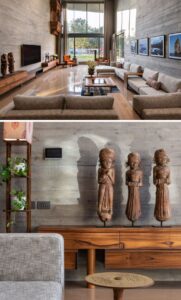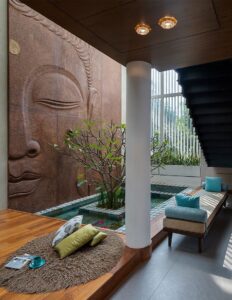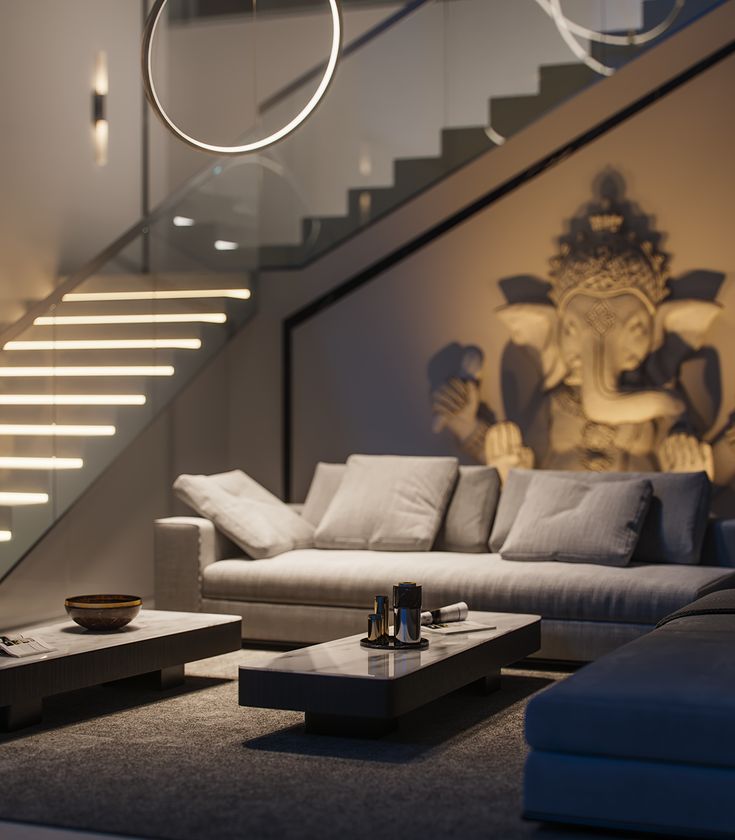In the vibrant tapestry of Indian culture, tradition is not just a relic of the past but a living, breathing essence that continues to shape contemporary life. Nowhere is this more evident than in the homes of modern Indians, where the old and the new coalesce to create spaces that are both timeless and dynamic. In this article, we delve into the art of incorporating cultural elements into modern Indian homes, celebrating heritage while embracing the future.
-
Understanding the Essence of Indian Culture:

- India’s cultural heritage is as diverse as it is rich, encompassing myriad traditions, languages, religions, and art forms.
- Central to Indian culture is the concept of “unity in diversity,” which emphasizes the coexistence and celebration of various cultural practices.
- Key elements of Indian culture include spirituality, vibrant colors, intricate patterns, and a deep reverence for nature.
-
Integrating Traditional Architecture:

- Traditional Indian architecture offers a treasure trove of inspiration for modern homes, with styles ranging from the ornate Mughal architecture to the serene simplicity of South Indian designs.
- Incorporating elements such as courtyards, verandas, and jharokhas (overhanging enclosed balconies) can add a touch of timeless elegance to contemporary residences.
- Architectural details like arches, domes, and jaali work (intricate lattice patterns) can be seamlessly integrated into modern structures, creating a harmonious blend of old and new.
-
Embracing Handcrafted Artistry:

- Handcrafted artifacts play a pivotal role in Indian culture, embodying centuries of craftsmanship and tradition.
- From intricately carved wooden furniture to vibrant textiles adorned with embroidery and mirror work, each piece tells a story of skill and heritage.
- Incorporating handcrafted elements into home decor adds warmth, character, and a sense of authenticity to modern interiors, bridging the gap between past and present.
-
Infusing Color and Texture:

- Color holds immense significance in Indian culture, with each hue carrying its own symbolic meaning.
- Bold, saturated colors like saffron, turquoise, and crimson are often used to evoke a sense of vitality and joy.
- Textures play an equally important role, with tactile materials like silk, cotton, and jute adding depth and visual interest to interior spaces.
- Experimenting with vibrant color palettes and rich textures can transform a mundane room into a dynamic expression of Indian heritage.
-
Celebrating Festivals and Rituals:
- Festivals form an integral part of Indian culture, offering opportunities for community gatherings, feasting, and spiritual reflection.
- Incorporating elements associated with festivals such as Diwali (the festival of lights), Holi (the festival of colors), and Navratri (nine nights of worship) can infuse homes with a sense of joy and festivity.
- Rituals like lighting diyas (oil lamps), hanging torans (door hangings), and creating rangoli (intricate floor designs) can become cherished traditions passed down through generations.

-
Honoring Spiritual Practices:

- Spirituality permeates every aspect of Indian life, influencing everything from daily rituals to architectural design.
- Designating a sacred space within the home, such as a puja room or meditation corner, provides a sanctuary for spiritual practice and reflection.
- Adorning the home with symbols of divinity such as statues of gods and goddesses, sacred scriptures, and auspicious symbols like the Om and Swastika, fosters an atmosphere of reverence and tranquility.
-
Sustaining Eco-Friendly Practices:
- Respect for nature is deeply ingrained in Indian culture, reflected in age-old practices such as organic farming, water conservation, and sustainable living.
- Modern Indian homes can embrace eco-friendly design principles by incorporating features like solar panels, rainwater harvesting systems, and natural ventilation.
- Using locally sourced materials, recycling/upcycling old furniture, and opting for energy-efficient appliances are practical ways to reduce environmental impact while staying true to cultural values.
-
Personalizing Spaces with Family Heirlooms:
- Family heirlooms hold sentimental value and serve as tangible links to ancestral heritage.
- Incorporating heirloom furniture, artwork, or artifacts into home decor not only adds a touch of nostalgia but also preserves familial traditions for future generations.
- Mixing old and new pieces creates a layered, eclectic aesthetic that reflects the evolving nature of Indian culture.
Conclusion: Incorporating cultural elements into modern Indian homes is not just about preserving tradition; it’s about honoring heritage while embracing innovation and progress. By weaving together the threads of the past
and present, homeowners can create spaces that are not only aesthetically pleasing but also deeply meaningful, reflecting the richness and diversity of Indian culture. In this fusion of old and new, tradition finds new life, enriching the tapestry of contemporary living.
